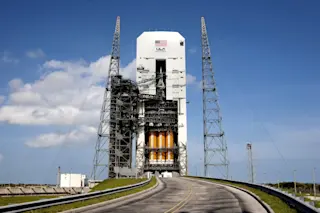Orion awaits its test flight on the launchpad. Credit: NASA/Kim Shiflett
Update (Friday, Dec. 5): At 11:29 a.m. Eastern Time NASA’s experimental Orion spacecraft splashed down in the Pacific Ocean, and in the process ushered in a new era of space exploration in the United States.
After launching at 7:05 a.m., the unmanned Orion spacecraft raced 3,630 miles above the Earth’s surface and into the Van Allen belt — a radiation cloud shrouding the planet. The entire journey lasted just over 4 hours, and Orion reentered the atmosphere reaching a speed of 20,000 miles per hour before deploying a series of parachutes to ensure a soft landing.It’s the highest any human-grade spacecraft has traveled in over four decades. Although Orion took radiation measurements in the Van Allen belt, the mission’s biggest success is that everything worked to near perfection. That’s a big win for NASA, since Orion is the craft ...














